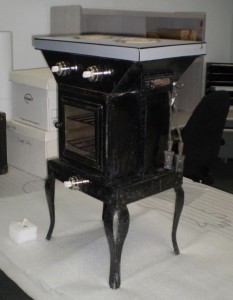Reading the artifact: A stove from a transitional moment
19 September 2013 – RASI 2012

The authors chose this enigmatic little stove for their week-long exploration. (Source: Canada Science and Technology Museums Corporation, No. 1981.0040)
In August 2012, a group of 26 doctoral students and museum professionals from different disciplines and multiple countries gathered at the Canada Science and Technology Museum (CSTM) in Ottawa, Canada, for the fourth annual Reading Artifacts Summer Institute (RASI). The one-week program, guided by staff and volunteers from the museum with guest scholar Dr. Allison Marsh, a historian of technology from the University of South Carolina, offered participants three avenues to investigate the role of artifacts in society:
- as historical sources with multiple cultural meanings that shift over time,
- as teaching tools in museum environments, and
- as three-dimensional objects whose preservation and storage present additional information–and challenges–to the work of curators, conservators, historians, and educators.
In the CSTM’s cavern-like storage warehouses, where artifacts range from delicate light bulbs to a massive mid-nineteenth-century steam engine, it became immediately apparent how much effort–intellectual, physical, and fiscal–is needed to maintain collections. This is not a new story for the curatorial world, but, in the midst of the Digital Revolution, where more and more objects, people, and places exist as digital representations and relationships, the week offered an opportunity to rethink how and in what ways our work with artifacts contributes to the construction of meaning in a pluralistic society.
On our first afternoon at RASI, our task was to choose an artifact and interrogate it with some starting assumptions, visual analysis, and eventually, documented sources. Participants were given the opportunity to choose from an array of objects, which included a hand-held X-ray device, a circa 1930s Nash motor-home, a portable camera, and a Victorian-style stove. Standing 34” high and weighing 27 pounds, this little stove was passed over by a number of the RASI participants in favor of examining the other more exotic objects drawn out of storage. Indeed, by comparison, this diminutive stove appeared quite enigmatic. Its appeal, however, drew the four of us together, and we began a week-long relationship with it, investigating its history, design, and functionality.
The first task on hand was to “read” the artifacts in order to discover their stories. RASI administrators kept the accession and catalog files from us so that participants had to rely on clues from a physical examination. Our stove’s lightweight design, use of electricity as a power source, and small oven led us to conclude that it was designed to be used by a small family or individual, perhaps in an urban setting. The stove also came with an additional accessory that resembled the bottom part of a modern light-bulb. It was ribbed, and the top-side had two holes in it, resembling a socket. Uncertain at first, we learned later that it was an adapter designed to be screwed into a light fixture in order to provide power to the stove if the household did not possess any base receptacles (images above and below).
The initial physical examination of the artifact was telling and revealed much about the possible period in which the stove was developed. The use of sheet metal and iron indicated the object was probably manufactured in the first half of the twentieth century. But the design of our stove was based on the style of a Victorian coal-fired stove and was representative of early twentieth-century domestic appliances that often imitated earlier aesthetics and design styles so that they could complement existing household layouts and interior possessions while utilizing newer power sources.[1]
It was obvious that this appliance was designed and built for a home or apartment with access to electricity. This fact helped narrow our initial assumptions about the approximate date of manufacture to the interwar decades. However, the inclusion of the adapter signaled some caution: if this appliance was built during a time when household electricity was commonplace, then why include it? We then mused at how the advent of electricity may have changed the design and construction of homes (to include base receptacles, for example) and at how long it would have taken owners of older homes to renovate and modernize their abodes. Further research revealed that our questions, prompted by this small stove, were not dissimilar from those asked within the scholarship on the history of electricity in North America.
As Ronald Tobey explained in his book Technology As Freedom, the electrification of society and everyday life faced many technological, social, economic, political, and geographical impediments. In the United States, the federal government moved slowly in supporting the growth of infrastructural developments for electricity. Until the 1930s, there was little public oversight of or investment in private utility companies, but this changed with the Great Depression. Through New Deal policies like the National Housing Act and the Tennessee Valley Authority, the US government helped reshape the consumer landscape by bringing electricity to neighborhoods and regions far beyond the power grids established by a private sector concerned primarily with profitability. But as Tobey points out, this was not a straightforward or instantaneous process, and it was complicated by technological limitations, such as the lack of small and quiet electrical motors for home appliances.[2] Indeed, if our little stove was built sometime during the interwar period, the inclusion of the adapter was both a shrewd marketing ploy by the manufacturer and material evidence of the impediments facing electrification.
However, given the maple leaf emblems and “Canadian Beauty” slogan written on the plugs, our group was fairly confident that this stove was Canadian-made and had likely “lived” in a Canadian home. So how did it fit into the wider story of electrification in Canada? Further research showed that there was a much heavier reliance on publicly owned utilities and projects in Canada, particularly at the provincial level of government where energy policy was primarily vested under the British North America Act.[3] By the beginning of the First World War, most urban centers in Ontario had street lights and electrically powered streetcars, but the World Wars and Great Depression put plans for rural electrification on hold until the 1950s. Although somewhat unlikely, it was possible that our stove was built earlier than the 1920s, given its fusion of late-Victorian design features, its possible use in an apartment, and the burgeoning availability of electricity in Canadian cities across the country.
While the day proved successful in determining a number of key factors regarding the design and social history of the stove, our group was still left with more questions than answers. What was the history of this object? What was its name? Who first bought it and for what purpose was it used? What company built and marketed it? Finally, how popular was it? Most of these questions would remain unanswered until we had an opportunity to explore the museum’s accession files and extensive trade-literature library.
Part 2 follows.
~ Laura A. Macaluso is a doctoral candidate in the humanities program at Salve Regina University in Newport, Rhode Island, United States. Jodey Nurse is a doctoral candidate in history at the University of Guelph in Guelph, Ontario, Canada. Emma O’Toole is a Government of Ireland doctoral scholar at the Faculty of Visual Culture, National College of Art & Design, Dublin,Ireland. Alex Souchen is a doctoral candidate in the Department of History at Western University in London, Ontario, Canada.
NOTES:
[1] See Christina Hardyment, From Mangle to Microwave: The Mechanization of Household Work (Cambridge: Polity Press, 1988) and Penny Sparke, Electrical Appliances (London & Sydney: Unwin Hyman, 1987).
[2] Ronald C. Tobey, Technology As Freedom: The New Deal and the Electrical Modernization of the American Home (Berkeley: University of California Press, 1996), especially pp. 1-40 and 62-92.
[3] Of particular significance was the creation in 1910 of the Ontario government’s Hydro Electric Power Commission (HEPC) which funded the Niagara Falls power project. It was North America’s first publicly owned utility, and it was mandated with providing municipalities with power at the lowest possible cost. Dorotea Gucciardo, “The Powered Generation: Canadians, Electricity, and Everyday Life” ( PhD diss., London, Ontario: The University of Western Ontario, 2011), chapters 1 and 2.






2 comments